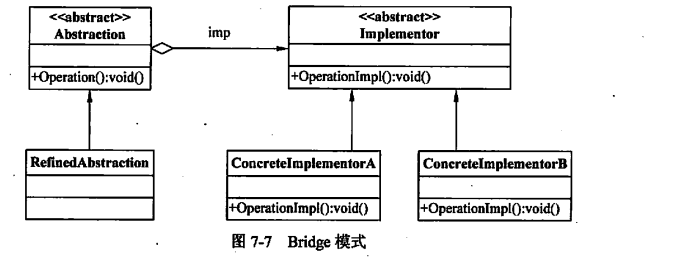桥接模式
About 2 min
桥接模式通过抽象和实现部分的分离,使得两者可以独立变化。抽象部分定义抽象类,维护一个对实现对象的引用。
实现部分定义实现接口,提供不同的实现。这样就可以通过组合不同的抽象类和实现类来创建对象,提高了系统的灵活性。

主要角色:
- 抽象(Abstraction):定义抽象接口,通常包含对实现接口的引用。
- 扩展抽象(RefinedAbstraction):对抽象的扩展,可以是抽象类的子类或具体实现类。
- 抽象实现(Implementor):定义实现接口,提供基本操作的接口。
- 具体实现(ConcreteImplementor):实现实现接口的具体类。
Info
在设计模式中类与类之间的关系主要有6种:依赖、关联、聚合、组合、继承、实现,它们之间的耦合度依次增加。子类必须实现抽象父类中的所有方法,父类抽象方法的变更,必然导致子类的变更。这是一种强关联关系。强关联有必然使我们的系统不易扩展。所以桥梁模式为化解强关联提供了一种解决方案。
桥接模式,抽象和实现的分离,可以理解为功能性的抽象和内部实现的分离。
当组件比较复杂,比如:属性存在复杂的依赖关系时,可以通过桥接模式进行拆分成多个组件。使得每个组件可以单独扩展,以此来简化组件,实现解耦。
代码实现
抽象
interface Implementor {
public void operationImpl();
}
扩展抽象
public class ConcreteImplementorA implements Implementor {
@Override
public void operationImpl() {
System.out.println("ConcreteImplementorA operation");
}
}
抽象实现
public abstract class Abstraction {
protected Implementor impl;
public void setImplementor(Implementor impl) {
this.impl = impl;
}
abstract public void operation();
}
这里聚合了Implementor,通过该类来实现我们的具体功能。
具体实现
public class RefinedAbstraction extends Abstraction {
public void operation() {
// do something
impl.operationImpl();
}
}
在抽象功能的实现类中,调用内部实现方法,完成operation的操作。
使用
public class Client {
public static void main(String[] args) {
Abstraction abstraction = new RefinedAbstraction();
abstraction.setImplementor(new ConcreteImplementorA());
abstraction.operation();
}
}
Abstraction和Implementor是Bridge模式中定义的两个抽象/接口,用于解耦抽象部分和实现部分。
为了保证原有组件的功能,在Abstraction中聚合Implementor,除了实现Abstraction自身的功能,通过调用Implementor的方法来完成其他功能。
这样Abstraction和Implementor可以独立变化,提高了系统的灵活性。





